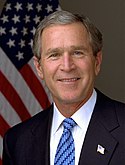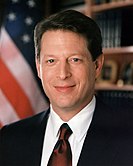United States presidential election in Arizona, 2000
|
|
||||||||||||||||||||||||||||||||
|
||||||||||||||||||||||||||||||||
|
||||||||||||||||||||||||||||||||
|
|
||||||||||||||||||||||||||||||||
|
County Results
Gore—60-70%
Gore—50-60%
Gore—<50%
Bush—<50%
Bush—50-60%
Bush—60-70%
|
||||||||||||||||||||||||||||||||
|
||||||||||||||||||||||||||||||||
The 2000 United States presidential election in Arizona took place on November 7, 2000 throughout all 50 states and D.C., which was part of the 2000 United States presidential election. Voters chose 8 representatives, or electors to the Electoral College, who voted for President and Vice President.
Arizona was won by Governor George W. Bush by a 6.3% margin of victory. Ralph Nader received 3%, as all of the other candidates received a combined 1%. Pre-election polling showed that Bush had a solid lead of Gore. Bush won all the congressional districts, except Arizona's 2nd congressional district. The key for Bush's victory was Maricopa County, which has by far the highest population in the state.
Technically the voters of Arizona cast their ballots for electors: representatives to the Electoral College. Arizona is allocated 10 electors because it has 8 congressional districts and 2 senators. All candidates who appear on the ballot or qualify to receive write-in votes must submit a list of 10 electors, who pledge to vote for their candidate and his or her running mate. Whoever wins the majority of votes in the state is awarded all 10 electoral votes. Their chosen electors then vote for President and Vice President. Although electors are pledged to their candidate and running mate, they are not obligated to vote for them. An elector who votes for someone other than his or her candidate is known as a faithless elector.
...
Wikipedia



